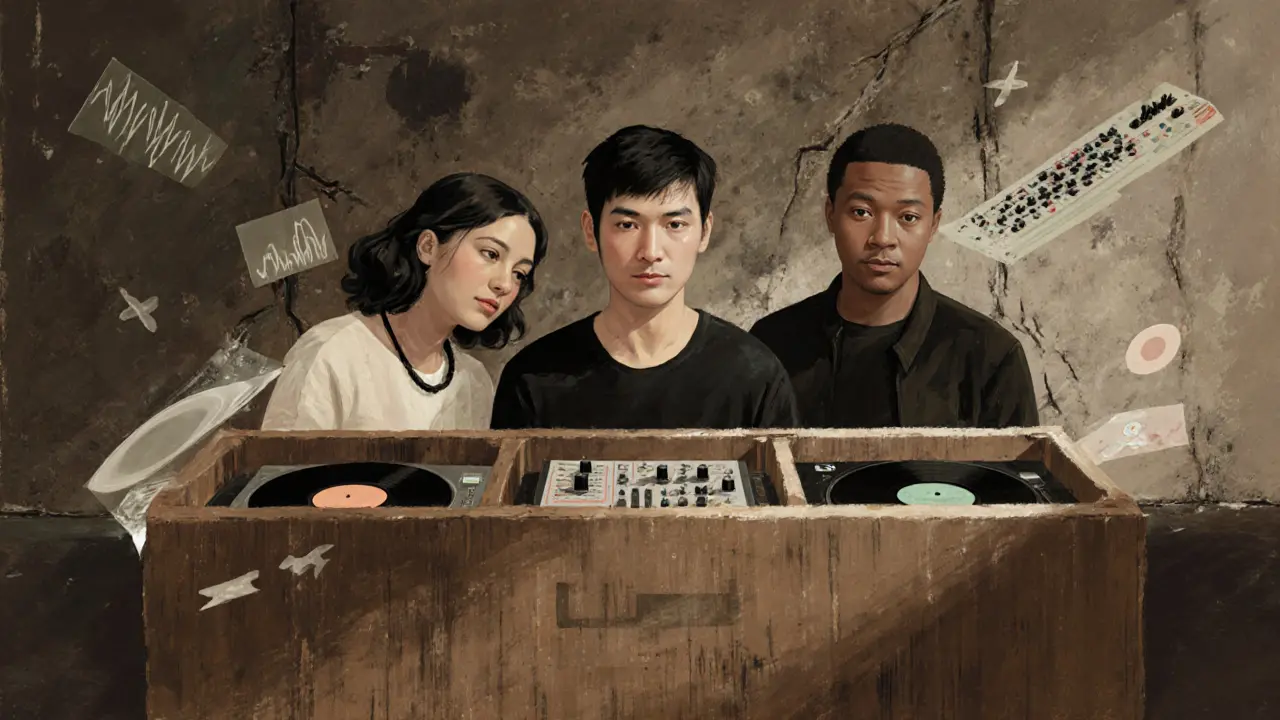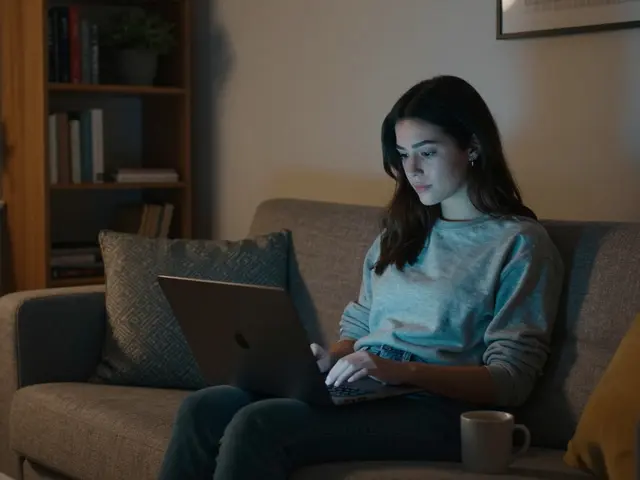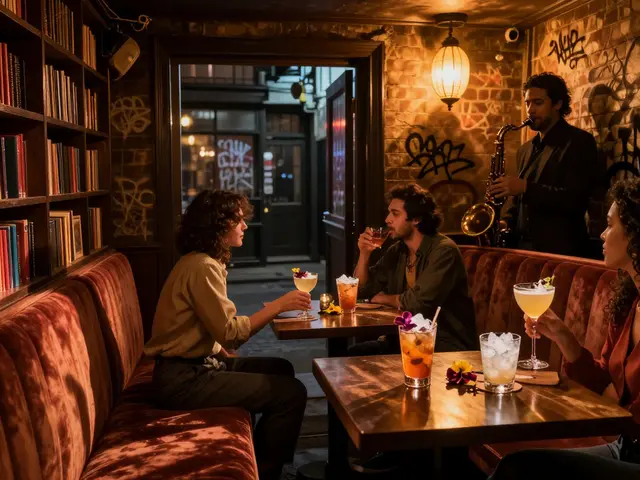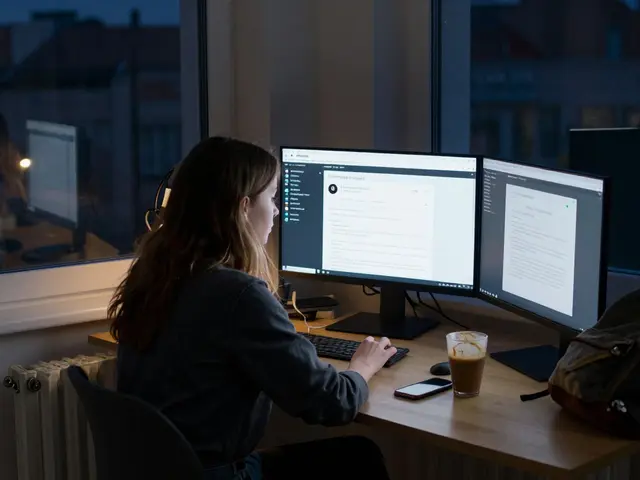
Ever wonder what happens behind the decks at Fabric? Not just the music, but the sweat, the silence before the drop, the way a DJ reads a room full of strangers and turns them into one heartbeat? Fabric isn’t just a club. It’s a living archive of electronic music history-and the people spinning the records are the ones keeping it alive.
What Makes Fabric Different?
Fabric opened in 1999 in a converted meat warehouse in Farringdon. No neon signs. No VIP ropes. No bottle service theatrics. Just two rooms, a legendary sound system, and a policy that says: let the music lead. That’s it. And for over 25 years, that’s been enough.
While other clubs chase trends, Fabric lets its DJs dig deep. You won’t find a DJ playing the same top 10 remixes here. Instead, you’ll hear a 12-minute techno track that builds like a storm, or a forgotten 1993 house record that makes the whole room freeze and then explode. This isn’t background noise. This is ritual.
The sound system? Built by Martin “Marty” Dyer, a sound engineer who spent years tuning speakers in abandoned warehouses. It’s called Fabric 3-a custom 12,000-watt setup that moves air like a live orchestra. People come from Tokyo, Berlin, Detroit just to feel it.
Meet the DJs: Voices from the Booth
We sat down with three DJs who’ve played Fabric regularly over the last decade. Not the headliners you see on posters. The ones who show up at 3 a.m., play for two hours, and leave without a selfie.
Maya Rios, a London-born producer who started as a barback at Fabric in 2015, now plays once a month. “I don’t play to impress,” she told us. “I play to remember. When I hear a track from 2001 that no one’s played in years, and someone in the crowd starts crying-I know I did my job.”
Leo Chen, who flies in from Taipei every six weeks, says Fabric changed his approach to DJing. “In Asia, clubs want energy, fast beats, big drops. Here? You can play silence for 40 seconds. And if the crowd stays quiet, that’s a win. It taught me patience.”
Harriet “Haze” Bell, a veteran of the UK rave scene, remembers the early days. “There was a time when the club didn’t even have a proper toilet. We’d play until 7 a.m., and people would just lie on the floor and sleep. No one cared. It was about the music. That’s still the rule.”
Why DJs Choose Fabric Over Bigger Clubs
Imagine being offered a headline slot at a club with 3,000 people, LED walls, and a $10,000 fee. Then you get a call from Fabric: 600 people, no lights, no visuals, £200 fee, and you play from 2 a.m. to 6 a.m.
They still say yes.
Why? Because Fabric doesn’t sell tickets. It sells trust. The crowd knows what they’re there for. They’re not there to be seen. They’re there to feel something real. DJs know that if they play something honest-something risky-they’ll be heard. Not just by ears, but by souls.
There’s a story about a DJ who played a 20-minute ambient piece in 2021. No beat. Just wind, rain, and distant church bells. Half the room left. The other half stood still. One guy cried. The next week, 300 people showed up asking for it again. That’s Fabric.
How to Get In (And What to Expect When You Do)
You won’t find a dress code. No suits. No sneakers. No rules. But there’s an unspoken one: come ready to listen.
Lines form around 10 p.m. on weekends. Entry is £15-£20. Cash is still accepted. No app. No QR code. Just a bouncer who looks you in the eye and says, “You here for the music?” If you nod, you’re in.
Inside, the rooms are dark. No screens. No flashing lights. Just a single spotlight on the decks. The bass hits your chest before you hear it. The crowd doesn’t cheer. They move. Slowly at first. Then like a tide.
People don’t take photos. Not because they’re not allowed-but because they don’t want to miss it. You don’t need a memory. You need to be there.

What’s on the Turntables? The Sound of Fabric
Fabric’s music isn’t a genre. It’s a language.
Room 1 is for techno-deep, hypnotic, minimal. Think basic beats, distorted kicks, and textures that feel like walking through fog. Artists like Reeko, Charlotte de Witte, and Ben Klock are regulars.
Room 2 is where house, disco, and experimental sounds collide. You might hear a 1978 funk record mashed with a 2024 modular synth loop. DJs like Andrew Weatherall (RIP), Shanti Celeste, and Yaeji have left their mark here.
There’s no playlist. No pre-set. No “must-play” tracks. Every set is built in the moment. A DJ might start with a 1996 jungle track, then slip into a 2023 ambient piece, then drop a 12-inch vinyl from a crate they found in a Berlin thrift store last week.
That’s the magic. You never know what you’ll hear. But you know it’ll be real.
How to Find Fabric and Plan Your Visit
Fabric is at 46-54 Charterhouse Street, Farringdon, EC1M 6JN. Nearest tube: Farringdon (Circle, Hammersmith & City, Metropolitan lines). Walk in from the main entrance-no side doors, no hidden alleys. Just a plain black door with a small white sign.
Check their website every Tuesday for the weekend lineup. No announcements on social media. No influencers. Just the official site. Dates fill up fast. If you want to go, don’t wait.
Arrive early. Bring cash. Leave your phone in your pocket. Wear comfortable shoes. And if you’re new? Go on a Wednesday. Smaller crowd. Less pressure. Just you and the music.
What to Expect: A Night at Fabric
It doesn’t feel like a night out. It feels like a pilgrimage.
You walk in. The air is cool, thick with the smell of old wood and sweat. The bass vibrates through the floor. You don’t see people dancing-you see people moving, like they’re underwater.
No one talks. Not much. When they do, it’s a whisper: “That’s the one.” Or, “I haven’t heard that since ’99.”
At 4 a.m., the lights come on for five minutes. Just enough to see the faces. Exhausted. Happy. Alive.
By 6 a.m., the last track fades. People leave quietly. No shouting. No selfies. Just a nod to the person next to them. They know what they shared.

Is It Worth It? The Real Cost of a Fabric Night
£20 for entry. £5 for a beer. £10 for a taxi home. That’s it.
Compare that to a club in Shoreditch where you pay £40, get a weak cocktail, and dance under a strobe for two hours while someone screams into a mic.
Fabric doesn’t sell drinks. It sells time. Time to lose yourself. Time to feel something you can’t explain. Time to be part of something bigger than a trend.
There’s no ROI here. No influencer post. No Instagram story. Just a memory you carry in your bones.
Fabric vs. Other London Clubs: The Real Difference
| Feature | Fabric | Ministry of Sound | The Cross | Printworks (Closed) |
|---|---|---|---|---|
| Sound System | Custom 12,000W, engineered for low-end depth | High-power, but designed for mainstream hits | Good, but focused on vocal house | Massive, but built for spectacle |
| Music Focus | Techno, house, experimental, vinyl-only | Commercial EDM, pop remixes | Classic house, disco | Big-room, festival-style |
| Lighting | Minimal, single spotlight on decks | Full LED, synchronized visuals | Colored spotlights | Massive laser shows |
| Entry Policy | Strictly music-first, no VIP | Reservations, bottle service, dress code | Some VIP sections | High ticket prices, celebrity crowd |
| Atmosphere | Intimate, reverent, underground | Party, social, tourist-friendly | Chill, retro | Grand, loud, event-based |
Frequently Asked Questions
Can I take photos at Fabric?
Technically, yes-but no one does. The culture is built on presence, not documentation. If you’re taking photos, you’re missing the point. The bouncers won’t stop you, but you’ll feel the silence around you. It’s not a rule. It’s a shared understanding.
Do I need to know techno to enjoy Fabric?
No. You just need to be open. Many first-timers come expecting EDM and leave stunned by a 15-minute track with no beat at all. It’s not about knowing the genre-it’s about letting the music take you somewhere unexpected.
Is Fabric safe?
Yes. Security is quiet but effective. Staff are trained to handle overdoses, anxiety, and dehydration. There’s a medical team on-site every night. No one gets kicked out for being tired or emotional. The club’s priority is care, not control.
Why is Fabric so strict about no VIP?
Because VIP culture kills the music. When people pay extra to be close to the DJ, it changes the energy. Fabric wants everyone equal. The person in the front row is just as likely to be a student on benefits as a record label boss. That’s why the music stays pure.
Can I just walk in without tickets?
Sometimes. If the event isn’t sold out, you can buy tickets at the door. But most weekends sell out days ahead. Check the website Tuesday nights. If it says “Sold Out,” it’s sold out. No exceptions.
Final Thought: Why Fabric Still Matters
In a world where everything is curated, filtered, and monetized, Fabric is an act of rebellion. Not loud. Not angry. Just quiet. Persistent. Real.
The DJs don’t post their sets on Spotify. The crowd doesn’t post about it on TikTok. But the music lives. In the bones of those who’ve been there. In the records that get dug up. In the next generation of kids who show up at 2 a.m., tired, confused, and ready to listen.
You don’t go to Fabric to be seen. You go to be found.







9 Comments
They say Fabric doesn't have VIPs but I bet the real insiders get invited to the back room where they play unreleased tracks from the 90s that never made it online. I heard from a guy who knows a guy who works with the sound engineer that they have a secret archive of 300+ unreleased mixes stored on hard drives no one else has access to. The bouncers? They're not just checking IDs-they're vetting your soul.
/p>You can't buy authenticity. You can't rent it. You can't Instagram it. Fabric isn't a club-it's a spiritual checkpoint for people who still believe sound can heal. Everyone else is just waiting for the next viral drop while the real ones are in the dark, listening to silence like it's scripture. The fact that you need to be quiet to hear it? That's the whole damn point.
/p>Oh wow, so Fabric's just like a church but with more bass and fewer hymnals? I'm shocked no one's started a cult around Maya Rios yet. Honestly, if I walked in and heard a 20-minute ambient piece of wind and church bells, I'd be texting my mom to say I think I've found God. Or at least a really good DJ.
/p>What strikes me most is how Fabric refuses to adapt to the digital age and yet somehow it thrives. No apps no QR codes no social media push no influencer partnerships. Just a black door and a bouncer asking if you're there for the music. That kind of integrity is rare. It's not anti-technology it's pro-soul. And the fact that people still show up? That says everything.
/p>THIS IS THE MOST IMPORTANT THING HAPPENING ON EARTH RIGHT NOW. PEOPLE ARE STILL CHOOSING REALNESS OVER REELS. I CRIED WHEN I READ ABOUT THE 20-MINUTE AMBIENT TRACK. THAT'S NOT MUSIC THAT'S A REVELATION. I'M BOOKING A FLIGHT TOMORROW. IF YOU'RE NOT AT FABRIC YOU'RE NOT LIVING YOU'RE JUST SCROLLING.
/p>Let’s be clear: Fabric isn’t ‘underground’-it’s the only legitimate sonic sanctuary left in a world drowning in algorithmic noise. The fact that you still have to pay £20 for entry and no one’s charging for ‘VIP experiences’ is a middle finger to the entire commodification of experience. And yes, the sound system is engineered like a Stradivarius-every watt calibrated to resonate with the primal cortex. Anyone who thinks techno is just ‘loud beats’ hasn’t felt the weight of a 12,000-watt subwoofer vibrating your sternum like a heartbeat from another dimension.
/p>I read this whole thing and I still think it's too romantic. People don't go to Fabric because it's sacred-they go because it's the only place left where they won't get scammed. The DJ gets £200? The club makes nothing? That's not magic-that's a business model that can't survive. Someone's got to be paying off the bouncers or the electricity bill. And don't even get me started on the 'no photos' rule. That's just control dressed up as spirituality.
/p>I went to Fabric last year after a bad breakup. Didn't know a single track. Just stood in the corner. By 4am I was crying quietly. Not because I understood the music but because I finally felt like I wasn't alone. No one said anything. No one looked. But the way the whole room moved together? Like we were breathing in sync. That's what I'll remember. Not the beats. The silence between them.
/p>That one guy crying during the ambient track? I’ve been there.
/p>